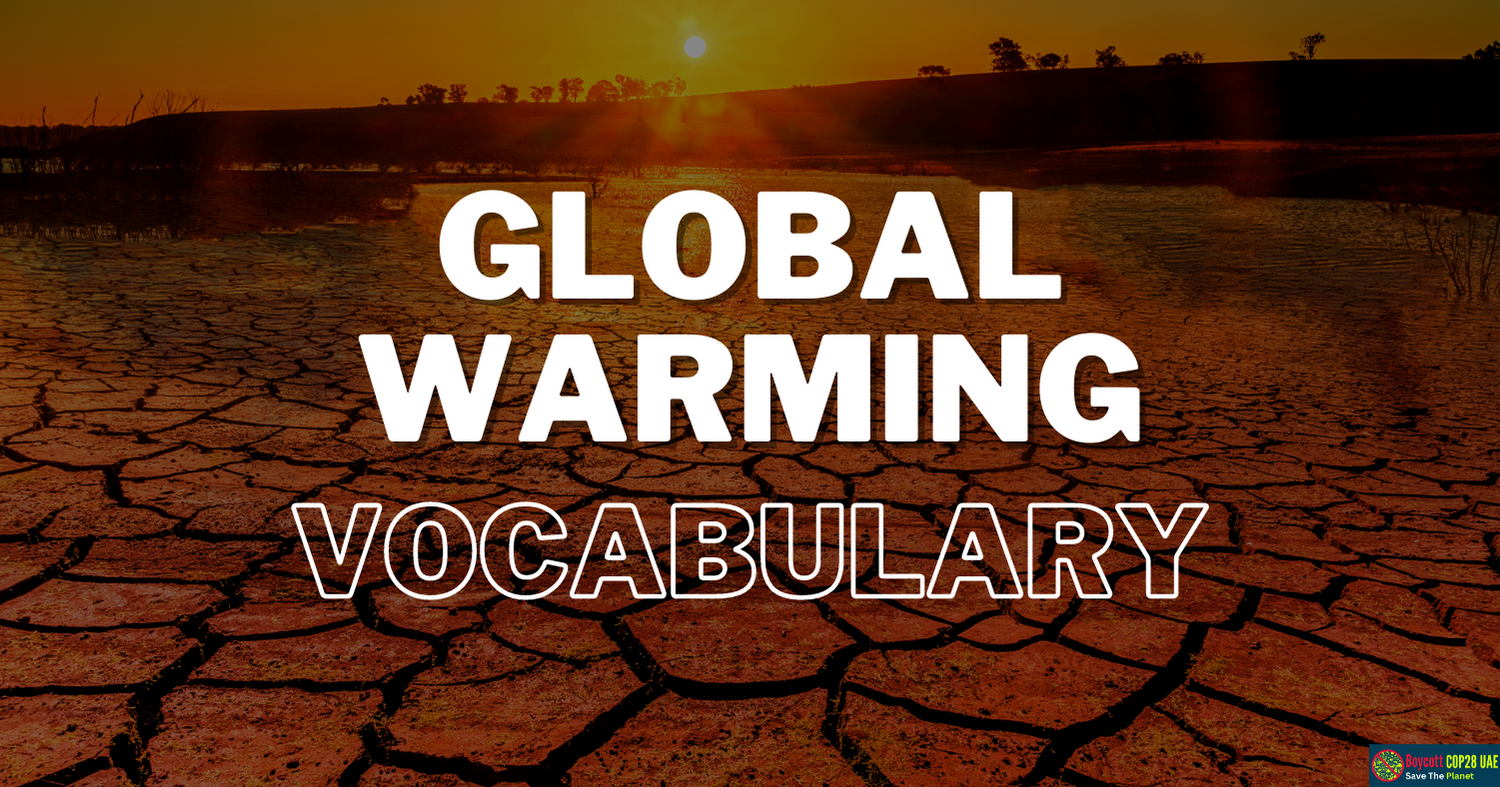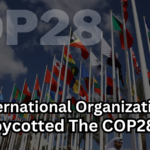1- Global Warming:
Global Warming is a gradual increase in the overall temperature of the Earth’s atmosphere, primarily caused by the emission of greenhouse gases from human activities.
2- Greenhouse Gases:
Gases that trap heat in the Earth’s atmosphere, contributing to the greenhouse effect. Examples include carbon dioxide, methane, and water vapor.
3- Climate Change:
A long-term shift in the Earth’s climate, including changes in temperature, precipitation, and weather patterns, caused by global warming.
4- Carbon Footprint:
The total amount of greenhouse gas emissions that are directly or indirectly caused by an individual, organization, event, or product.
5- Carbon Dioxide:
A colorless, odorless gas that is a primary greenhouse gas and is emitted by the burning of fossil fuels, deforestation, and other human activities.
6- Methane:
A colorless, odorless gas that is a potent greenhouse gas and is emitted by agriculture, fossil fuel production, and landfills.
7- Fossil Fuels:
Non-renewable energy sources, such as coal, oil, and natural gas, that are formed over millions of years from the remains of ancient plants and animals.
8- Renewable Energy:
Energy that is generated from natural resources that can be replenished, such as solar, wind, and hydroelectric power.
9- Deforestation:
The clearing of forests for agricultural or commercial purposes, which contributes to global warming by reducing the amount of carbon dioxide that can be absorbed by trees.
10- Climate Adaptation:
The process of adjusting to the impacts of climate change, such as rising sea levels, increased frequency of extreme weather events, and changing ecosystems.
11- Climate Mitigation:
The process of reducing greenhouse gas emissions to slow the rate of global warming and minimize the severity of climate change impacts.
12- Carbon Sequestration:
The process of capturing and storing carbon dioxide from the atmosphere, such as through reforestation or the use of carbon capture and storage technology.
13- Ocean Acidification:
The process by which the pH of seawater decreases due to the absorption of carbon dioxide from the atmosphere, which can have negative impacts on marine ecosystems.
14- Renewable Energy Certificates (RECs):
Certificates that represent proof that one megawatt-hour (MWh) of electricity was generated from a renewable energy technology and source, which can be used to offset greenhouse gas emissions.
15- Energy Efficiency:
The practice of using less energy to achieve the same level of output, such as through the use of energy-efficient appliances or buildings.
16- Permafrost:
A layer of frozen soil and rock that covers about 25% of the land in the Northern Hemisphere, which is melting due to global warming, releasing large amounts of methane and carbon dioxide into the atmosphere.
17- Sea Level Rise:
The increase in the average global sea level due to the melting of glaciers and ice sheets and the thermal expansion of seawater, which can cause flooding in coastal areas and displacement of populations.
18- Biodiversity:
The variety of living organisms in a particular ecosystem or on Earth as a whole, which is being threatened by climate change and other human activities.
19- Green Energy:
Energy that is generated from renewable sources and does not emit greenhouse gases, such as solar, wind, geothermal, and hydropower.
20- Adaptation Fund:
A fund established by the United Nations Framework Convention on Climate Change (UNFCCC) to help developing countries adapt to the impacts of climate change.
21- Paris Agreement:
An international treaty adopted in 2015 by the United Nations Framework Convention on Climate Change (UNFCCC), in which countries committed to reducing greenhouse gas emissions and limiting global warming to well below 2 degrees Celsius above pre-industrial levels.
22- Carbon Pricing:
A policy that puts a price on greenhouse gas emissions, either through a tax or a cap-and-trade system, in order to incentivize the reduction of emissions.
23- Carbon Neutral:
The state of having a net zero carbon footprint, achieved by reducing emissions and offsetting remaining emissions through activities such as planting trees or investing in renewable energy.
24- Carbon Offset:
A reduction in greenhouse gas emissions made in one place to compensate for emissions produced in another place, typically achieved through the purchase of carbon credits.
25- Climate Finance:
Financial resources provided by developed countries to support developing countries in their efforts to mitigate and adapt to climate change.
26- Climate Resilience:
The ability of an ecosystem or community to withstand and recover from the impacts of climate change, such as extreme weather events, sea level rise, and drought.
27- Climate Justice:
The idea that the impacts of climate change and the efforts to address them should be distributed fairly and equitably, particularly to vulnerable populations who have contributed least to the problem.
28- Clean Energy:
Energy that is generated from renewable sources or that has low or zero greenhouse gas emissions, such as solar, wind, hydro, geothermal, nuclear, and biomass energy.
29- Climate Action:
The steps taken by individuals, organizations, and governments to reduce greenhouse gas emissions, adapt to the impacts of climate change, and transition to a more sustainable and resilient economy.
30- Energy Transition:
The shift from fossil fuels to clean energy sources and the implementation of more efficient and sustainable energy systems, including transportation and buildings.
31- Carbon Capture and Storage (CCS):
Carbon Capture and Storage (CCS) is a technology that captures carbon dioxide emissions from power plants, industrial processes, and other sources and stores them underground, preventing them from entering the atmosphere.
32- Ecological Footprint:
A measure of the impact of human activities on the environment, including land use, energy consumption, and greenhouse gas emissions.
33- Mitigation Potential:
The amount of greenhouse gas emissions that can be avoided or reduced through various mitigation strategies, such as energy efficiency, renewable energy, and carbon pricing.
34- Sustainable Development:
Development that meets the needs of the present without compromising the ability of future generations to meet their own needs, including social, economic, and environmental sustainability.
35- Climate Modeling:
The use of computer simulations to project future climate conditions based on different scenarios of greenhouse gas emissions and other factors.
36- Carbon Intensity:
The amount of carbon dioxide emissions per unit of energy or economic output, used as a measure of the carbon efficiency of an economy or activity.
37- Climate Feedbacks:
The processes by which changes in the Earth’s climate system can amplify or dampen the effects of greenhouse gas emissions, such as changes in cloud cover, ocean circulation, and permafrost melting.
38- Carbon Sequestration and Storage (CSS):
The process of capturing and storing carbon dioxide from the atmosphere or industrial processes in geological formations, deep ocean, or underground reservoirs to reduce greenhouse gas emissions.
39- Carbon Neutrality:
Achieving a net zero carbon footprint through a combination of reducing emissions and offsetting remaining emissions through carbon credits or other means.
40- Climate Emergency:
A term used to describe the urgency and severity of the impacts of climate change, and the need for rapid and transformative action to mitigate and adapt to these impacts.
41- Climate Refugees:
People who are forced to migrate or relocate due to the impacts of climate change, such as sea level rise, desertification, and extreme weather events.
42- Decarbonization:
The process of reducing or eliminating carbon emissions from various sources, such as power plants, transportation, and buildings, to achieve net zero emissions.
43- Emissions Reduction Targets:
The specific goals or targets set by governments, organizations, and individuals to reduce greenhouse gas emissions within a certain timeframe, such as 50% reduction by 2030.
44- Greenhouse Gas (GHG):
Gases that trap heat in the Earth’s atmosphere, such as carbon dioxide, methane, and nitrous oxide, contributing to global warming and climate change.
45- Intergovernmental Panel on Climate Change (IPCC):
A scientific body established by the United Nations to provide regular assessments of the state of knowledge on climate change, including its impacts, causes, and mitigation strategies.
46- Sustainability:
The ability to meet the needs of the present without compromising the ability of future generations to meet their own needs, including economic, social, and environmental sustainability.
47- Terrestrial Carbon Sink:
The ability of land ecosystems, such as forests, grasslands, and wetlands, to absorb and store carbon from the atmosphere, helping to mitigate the impacts of climate change.
48- UNFCCC:
The United Nations Framework Convention on Climate Change, an international treaty signed by nearly every country in the world to address the issue of climate change, and the governing body responsible for the annual COP conferences.






